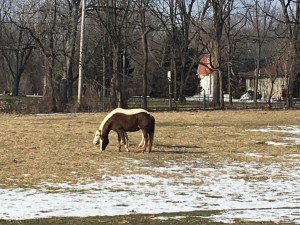Equine herpes virus outbreak hits northern Illinois
Adela Crandell Durkee — February 10, 2016
Although Equine Herpes Virus cannot be prevented, the spread can be thwarted. Many farms in the area initiated voluntary quarantines for the 21-day incubation period, owners avoid shows, and races while new cases are emerging. (Photo by Adela Crandell Durkee/for Chronicle Media)
Although Equine Herpes Virus cannot be prevented, the spread can be thwarted. Many farms in the area initiated voluntary quarantines for the 21-day incubation period, owners avoid shows, and races while new cases are emerging. (Photo by Adela Crandell Durkee/for Chronicle Media)
Eight horses at Bartlett’s Sunset Hill Farm became ill with Equine Herpes Virus (EHV-1) in late January.
Sunset Hill is a boarding farm, housing 40 horses. All eight infected horses were euthanized. According to Illinois Department of Agriculture officials, the lack of new cases does not mean the outbreak is contained.
EHV-1 is not a reportable disease, so veterinarians are not required to report cases to the state.
The Illinois Department of Agriculture placed Sunset Hill, which houses 40 horses, under quarantine. McHenry County has no reported cases of EHV-1 for 2016. EHV-1 is not transmitted to humans.
Symptoms of EHV-1 infection in young horse include cough, decreased appetite, depression, and a nasal discharge. Although the virus is common, and usually mild, during the winter months, because it is carried in the blood, it can result in serious complications.
EHV-1 can travel to the uterus. Pregnant mares typically show no signs of infection before they spontaneously abort, usually, late in gestation (around eight months), but can be earlier. Foals born from infected mothers rarely survive.
Horses with the neurologic form usually have a fever in the beginning, and later become uncoordinated, weak and paralyzed in the fore and hind limbs.
EHV-1 is highly contagious among horses. In 2016, New Mexico, Arizona, Pennsylvania, and Illinois reported cases. The most common places for outbreaks are horse shows and races.
Although EHV-1 cannot be prevented, the spread can be thwarted. Many farms in the area initiated voluntary quarantines for the 21-day incubation period, owners avoid shows, and races while new cases are emerging. Farms in Gilbert, Sleepy Hollow, Bartlett, and elsewhere are taking precautions. More than 300 horses became voluntarily quarantined.
EHV-1 spreads through nasal secretions and through contact with surfaces and shared equipment where secretions land. Containment can be difficult because other diseases, such as equine flu, can exhibit the same early symptoms. The virus usually lives for 7 days in the environment, but if conditions are right, EHV-1 can live for a month outside the horse’s body.
Veterinarians can vaccinate horses, and many horses in the area are vaccinated. Veterinarians can give boosters to previously vaccinated horses. Like the flu vaccine for humans, the EHV-1 vaccine cannot completely protect a horse from the virus, but it may lessen the symptoms and increase a horse’s immunity.
The two best ways to prevent EHV-1 is vaccination and what’s known as “biosecurity.” Biosecurity means doing everything possible to prevent the disease from being carried onto the farm by people, animals, equipment, or vehicles. Anything that touches an infected horse or sheds secretions from sick horses has the potential to transfer diseases to other horses. Good hygiene, coupled with keeping horses and their equipment separated, goes a long way toward preventing the spread of EHV-1 once an infection occurs on a farm.
— Equine herpes virus outbreak hits northern Illinois —







